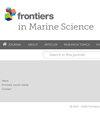南海北部甲烷渗流作用下黄铁矿中微量金属富集过程
IF 3
2区 生物学
Q1 MARINE & FRESHWATER BIOLOGY
引用次数: 0
摘要
黄铁矿是甲烷渗流的重要标志。有机硫酸盐还原(OSR)和硫酸盐驱动甲烷厌氧氧化(SD-AOM)对黄铁矿中微量金属的影响引起了人们的关注;然而,这两种途径如何控制微量元素模式仍需进一步研究。为此,我们对南海北部沉积物样品的地球化学和矿物学特征进行了研究,旨在探讨甲烷渗漏体系中微量元素富集黄铁矿的机制。采用激光烧蚀-电感耦合等离子体质谱(LA-ICP-MS)分析了Z22-3岩心中黄铁矿的微量元素谱图。利用Sr/Ca- mg /Ca、(Mo/U) EF值、铬还原性硫(CRS)含量、总有机碳(TOC)、δ34S和δ13C值确定沉积物中硫酸盐-甲烷过渡带(SMTZs)位置。CRS δ34S值逐渐增大(最大可达- 36.54‰),Mg/Ca增大,表明SD-AOM增强,表明SMTZs的位置位于181 ~ 481和1101 ~ 1401 cmbsf深度。黄铁矿中Co、Ni、Mo和Pb富集,Mn、Zn、Cu和v富集。讨论了甲烷渗流对黄铁矿中微量元素的影响过程:AOM的增强和亚铁在黄铁矿中的取代促进了铁/锰氧化团聚体的还原性溶解,促进了黄铁矿中Mo、Co和Ni的富集。水交换动力学速率比铁快的元素,如Cu、Pb、Zn等,不与黄铁矿结合,而是作为独立的金属硫化物沉淀,导致黄铁矿中这些微量元素的耗损。本研究为研究深海沉积物与自生黄铁矿之间的微量元素循环提供了新的思路,建立了基于黄铁矿微量元素模式的AOM地球化学指标。本文章由计算机程序翻译,如有差异,请以英文原文为准。
The process of trace metals enrichment in pyrite under methane seepage in the northern South China Sea
Pyrite is an important indicator of methane seepage. The effects of organic sulfate reduction (OSR) and sulfate-driven anaerobic oxidation of methane (SD-AOM) on the trace metals in pyrite have aroused interest; however, further studies about how these two pathways control the trace element patterns are still required. Therefore, we studied the geochemical and mineralogical characteristics of sediment samples from the northern South China Sea, aiming to investigate the enrichment mechanisms of trace elements into pyrites in methane seep systems. We applied laser ablation–inductively coupled plasma–mass spectrometry (LA-ICP-MS) to analyze the trace element patterns of pyrites in core Z22–3. We used Sr/Ca-Mg/Ca, (Mo/U) EF values, chromium reducible sulfur (CRS) content, total organic carbon (TOC), δ34 S, and δ13 C values of bulk sediments to determine the position of sulfate–methane transition zones (SMTZs). Progressively more positive δ34 S values (up to −36.54‰) of the CRS and an increase in Mg/Ca indicate the enhancement of SD-AOM, suggesting that the position of SMTZs is located at depths of 181 to 481 and 1,101 to 1,401 cmbsf. Within SMTZs, pyrites exhibit obvious enrichments in Co, Ni, Mo, and Pb and depletion in Mn, Zn, Cu, and V. We discuss the process of methane seepage affecting trace elements in pyrites: the reductive dissolution of iron/manganese oxyhydroxide aggregates fueled by the enhancement of AOM and substitution for ferrous in pyrites contribute to the enrichments of Mo, Co and Ni in pyrites. Elements with faster water exchange kinetics rates than Fe, such as Cu, Pb and Zn, rather precipitate as independent metal sulfides than incorporating into pyrite, thus resulting in the depletion of these trace elements in pyrites. This study provides novel insight into the deep-sea trace element cycle between sediments and authigenic pyrites, establishing geochemical indicators of AOM based on trace element patterns in pyrites.
求助全文
通过发布文献求助,成功后即可免费获取论文全文。
去求助
来源期刊

Frontiers in Marine Science
Agricultural and Biological Sciences-Aquatic Science
CiteScore
5.10
自引率
16.20%
发文量
2443
审稿时长
14 weeks
期刊介绍:
Frontiers in Marine Science publishes rigorously peer-reviewed research that advances our understanding of all aspects of the environment, biology, ecosystem functioning and human interactions with the oceans. Field Chief Editor Carlos M. Duarte at King Abdullah University of Science and Technology Thuwal is supported by an outstanding Editorial Board of international researchers. This multidisciplinary open-access journal is at the forefront of disseminating and communicating scientific knowledge and impactful discoveries to researchers, academics, policy makers and the public worldwide.
With the human population predicted to reach 9 billion people by 2050, it is clear that traditional land resources will not suffice to meet the demand for food or energy, required to support high-quality livelihoods. As a result, the oceans are emerging as a source of untapped assets, with new innovative industries, such as aquaculture, marine biotechnology, marine energy and deep-sea mining growing rapidly under a new era characterized by rapid growth of a blue, ocean-based economy. The sustainability of the blue economy is closely dependent on our knowledge about how to mitigate the impacts of the multiple pressures on the ocean ecosystem associated with the increased scale and diversification of industry operations in the ocean and global human pressures on the environment. Therefore, Frontiers in Marine Science particularly welcomes the communication of research outcomes addressing ocean-based solutions for the emerging challenges, including improved forecasting and observational capacities, understanding biodiversity and ecosystem problems, locally and globally, effective management strategies to maintain ocean health, and an improved capacity to sustainably derive resources from the oceans.
 求助内容:
求助内容: 应助结果提醒方式:
应助结果提醒方式:


